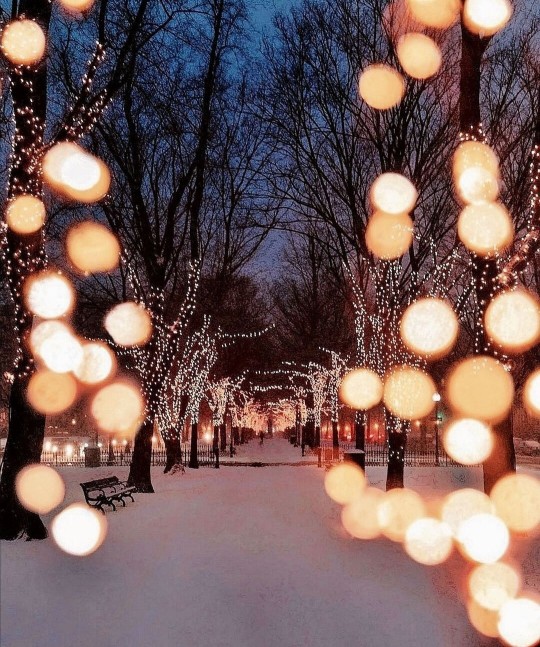Don't wanna be here? Send us removal request.
Text
18K notes
·
View notes
Note
any advice on making capes?
Ooh, I love capes!
Making capes
Types of capes:
There are different types of capes. Let's take a look at a few options.
Rectangle cape: the type of cape American superheroes wear. They consist out of a simple rectangle that can be tied or clasped at the neck. Use gathered fabric for extra fullness. This type of cape won't give you a lot of warmth as it will only cover your back.
Quarter circle cape: slightly more flared than a rectangle cape, but will still only cover your back.
Half circle cape: will cover both your back and shoulders and some of your body, which will give you extra warmth. Great for drama!
Fitted half circle cape: similar to a half circle cape, but made out of three separate pieces to fit around your body better. It won't cover you completely, but it will cover your back, shoulders, and more of your body than a normal half circle cape would.
Full circle cape: this cloak will cover your full body and keep you nice and warm.
Savvy sewists will notice these cape types are similar to circle skirts. The idea's basically the same. Instead of making a skirt, you leave your circle open in the front, and cut a hole that fits your neck rather than your waist.
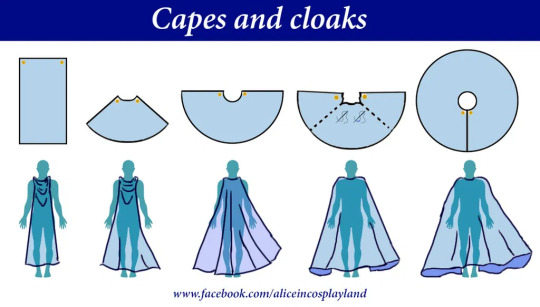
(Image source) [ID: drawing showing five types of coats: rectangle, quarter circle, half circle, half fitted circle, full circle. Text: "Capes and cloaks. www.facebook.com/aliceincosplayland".]
Aside of volume, you can also play around with length. A floor-length cape has a very different effect and function than a cape that reaches your hips, or even a capelet.
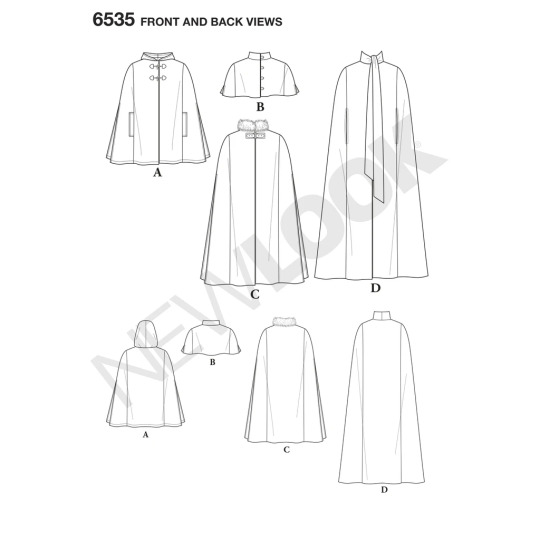
(Image source) [ID: a pattern diagram showing four different cape lengths: floor length, hip length, waist length, and a capelet. Text: "6535 Front and back views. Newlook."]
Details like a hood or armholes can make your cape extra comfortable, and you've got a wide range of options when it comes to fasteners, too.
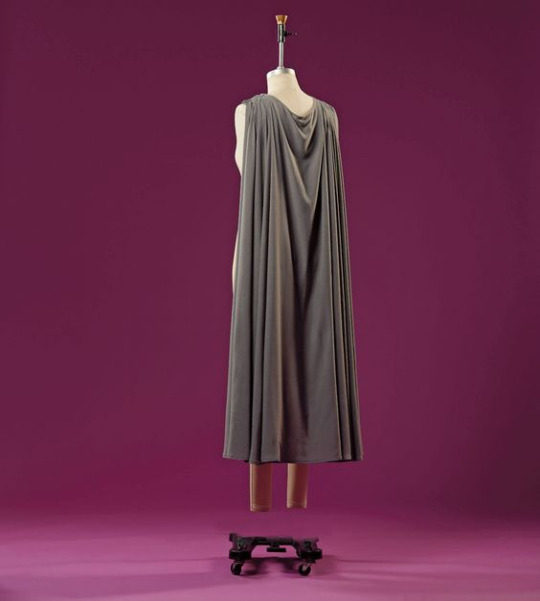
(Image source) [ID: back view of a long gray half circle cape that's been pleated at the shoulders.]
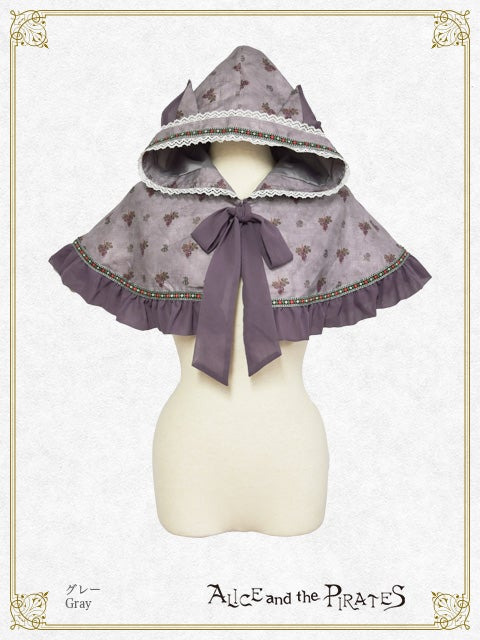
(Image source) [ID: a purple capelet with a hood, frills, cat ears, and lace, tied with a bow at the front. Text: "Gray. Alice and the Pirates."]
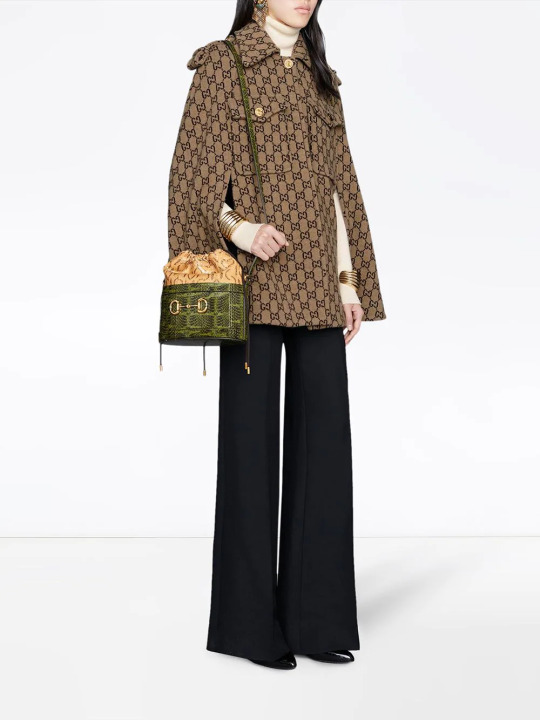
(Image source) [ID: a person wearing a brown monogrammed hip-length cape with front pockets and arm slits at the sides.]
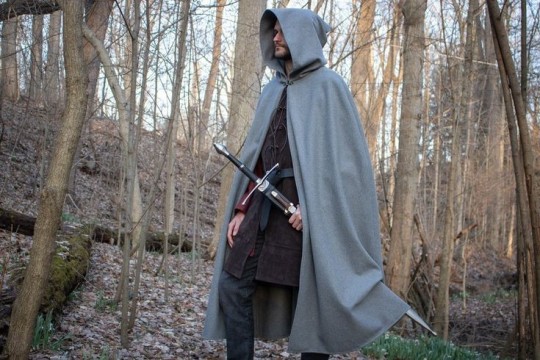
(Image source) [ID: a person wearing a long gray hooded cape, standing in a forest and holding a sword.]
Materials:
Before deciding what fabrics to make your cloak or cape out of, ask yourself what you're trying to achieve first.
Warmth, drape, fabric price, comfort, aesthetic, wearing context,... are some examples of things that can influence your decision.
Some examples:
A cosplay cloak has to look good but doesn't necessarily have to be warm. Choose a fabric that's suitable for your character's outfit, but also keep the circumstances in which you plan to wear your outfit in mind. For example, a warm cloak might pose issues if you do a lot of indoor photo shoots, but convention halls can be pretty chilly.
A fashion cloak intended for winter really does need to be warm! Wool, tweed, and velvet are good options.
A cloak intended for historical re-enactment preferably uses period-accurate materials and therefore won't be lined with fabrics like polyester and such. Which fabric to use depends on the period and region you're working in.
Tutorials and patterns:
Here's a few tutorials/patterns to get you started:
Fitted cloak: winterberry cape (Mood)
How to draft your own hooded cape (The Spruce Crafts)
Pleated half circle cape (Gilian Conahan)
Half circle capelet (Buzzfeed)
Long hooded cloak (Fleece Fun)
Full circle capelet (Project Run and Play)
Four ways to make a cape (WikiHow)
Eight types of capes (Sew Guide)
Half circle fashion cape (Indoor Shannon)
21 free cape sewing patterns (Love Sewing)
Hooded cloak with lining (Online Fabric Store)
Conclusion:
Capes and cloaks make for fun sewing projects. They're pretty easy to make: if you know how to draw circles, you know how to draft a cape pattern.
Capes are a versatile garment, and can range from a great last-minute Halloween costume to an every-day winter cloak. Play around with materials, lengths, shapes, design elements, decoration,... to achieve different effects.
And most of all: have fun with it!
28K notes
·
View notes
Text
2022 Witch's Calendar
For all my witches out there, here's a handy list of the 2022 dates for the major holidays, full and new moons, and special events. I've listed my sources at the bottom. Dates and times for all events are calculated for Eastern Standard Time, USA, Northern Hemisphere. Adjust for your location as needed. Enjoy!
WOTY Holidays and Solstices
February 1-2 - Imbolc
March 20 - Spring Equinox / Ostara
May 1 - Beltane
June 21 - Summer Solstice / Midsummer
August 1 - Lughnasadh
September 22 - Autumn Equinox / Mabon
October 31 - Samhain
December 21 - Winter Solstice / Yule
Full Moons
January 17 - Wolf Moon ♋️
February 16 - Snow Moon ♌️
March 18 - Worm Moon ♍️
April 16 - Pink Moon ♎️
May 16 - Flower Moon ♏️
June 14 - Strawberry Moon ♐️
July 13 - Thunder Moon (aka Buck Moon) ♑️
August 11 - Sturgeon Moon ♒️
September 10 - Harvest Moon ♓️
October 9 - Hunter's Moon (aka Blood Moon) ♈️
November 8 - Frost Moon ♉️
December 7 - Cold Moon ♊️
Fun Fact: The title of Harvest Moon is given to either the September or October full moon, whichever falls closest to the autumn equinox. In 2022, that month will be September.
New Moons
January 2 ♑️
February 1 ♒️
March 2 ♓️
April 1 ♈️
April 30 ♉️
May 30 ♊️
June 29 ♋️
July 28 ♌️
August 27 ♍️
September 25 ♎️
October 25 ♏️
November 23 ♐️
December 23 ♑️
Special Events
April 30 - Black Moon & Partial Solar Eclipse (10:42pm EST)
May 16 - Total Lunar Eclipe (12:11am EST, coinciding with zenith)
June 14 - Supermoon
July 13 - Supermoon
October 25 - Partial Solar Eclipe (11:01am EST)
November 8 - Total Lunar Eclipse (5:59am EST, coinciding with zenith)
SOURCES:
Inverse - Full Moon 2022 calendar: Dates, times, schedule, and names for the brightest nights all year
Astroseek - Full Moons 2022 & New Moons
The Pagan Grimoire - The Wheel of the Year: The 8 Festivals in the Wiccan Calendar
15K notes
·
View notes
Text
Color Correspondences
This is a common topic for beginners to research, and I would argue can be important when starting your practice. There are dozens of posts online about color correspondences, but I thought I'd share my own perspective on the topic. Just about every post I see on this topic is the same regurgitated information; all of which lacking in sharing the baneful aspects of color correspondences.
When researching something like color correspondences, I like to consider the psychological connections between colors and what they are associated with. By looking at color correspondences from this perspective, we can get a better idea of how we can utilize colors in our practices. That being said, here is a list of colors and what I associate them with. Anything before the semicolon are potential positive associations; anything after the semicolon are potential negative associations.
White: Purification, Peace, New Beginnings; Isolation
Grey: Neutrality, Balance, Compromise; Depression, Detachment, Indecision
Black: Protection, Banishment, Binding, Cursing, Power; Fear, Pessimism
Purple: Inspiration, Creativity, Individuality, Intuition, Spirituality; Arrogance, Delusion
Blue: Communication, Truth, Intellect, Wisdom, Calm; Deceit, Manipulation
Green: Abundance, Prosperity, Growth, Wealth, Fertility, Restoration; Envy, Greed
Brown: Grounding, Stability, Strength, Warmth; Materialistic, Stingy
Yellow: Optimism, Joy, Confidence; Anxiety, Impulsive, Cowardly
Orange: Adventurous, Friendship, Vitality; Indulgent, Cynical
Pink: Compassion, Nurturing, Hope, Innocence; Weakness, Naïve
Red: Passion, Assertiveness, Power, Determination, Courage, Energy; Aggression, Violence
Silver: Reflection, Illumination, Dignity; Lonely
Gold: Success, Charisma; Egocentric
Now, this doesn't share my full thoughts on each color. We all have our own personal opinions of every color, which can change what they mean to us. Therefore, it can change how we utilize color correspondences in our practices.
I mention baneful correspondences because I know there are people out there who do baneful workings, or may do baneful workings one day. I don't have a problem with such things, though I do have strict morals that help me determine when something is worth baneful magick. Most circumstances don't need such things, but sometimes they might.
I'd also like to mention my own little unpopular opinion here: white isn't an all-purpose color. You may have differing opinions, and that is okay, but I don't believe it to be an all purpose color. I do feel that multiple colors can serve a similar purpose, depending on how you view the colors.
Green, brown and gold can all be used for wealth, abundance and prosperity. Yellow and orange can be used for travel related spellwork and confidence. White and silver can be used for healing. See what I mean?
I still encourage you to do your own research and come to your own conclusions. This is only meant to offer some perspective.
1K notes
·
View notes
Text
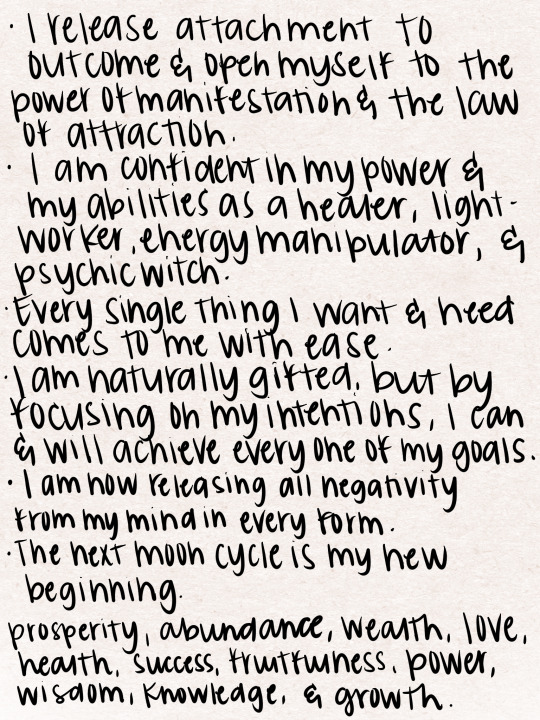
Manifestation is about release as much as it is about belief and the power of positive thought.
In order to step into your power, you must first release all self-doubt, pessimism, and attachment to outcome.
The universe is always listening.
401 notes
·
View notes
Text
Retrogade in planets usage
Mercury - connect with old friends
Venus - heal any relationship issues
Mars - get into an exercise routine
Jupiter - travel to a favourite place
Saturn - practice self-discipline
Uranus - study up on current events
Neptune - cut the energy vampires out of your life
Pluto - declutter your space
374 notes
·
View notes
Text
Yule & The Winter Solstice 101
Summer is over, Winter is in full swing, and Yule is upon us.

Yule, pronounced “yool”, falls on the 21st of December in the Northern Hemisphere, a date that is also known as the Winter Solstice. In the Southern Hemisphere (below the equator), Yule falls on the 21st of June.
The Winter Solstice is the day of the year when the night is longest and the day is shortest. After the solstice, the days begin to grow longer and the nights shorter.
Some Historical & Cultural Stuff:
Yule is the time of the year when the “dark half” of the year ends and the “light half begins”.
Until the 16th century, the winter months were infamous for being times of famine in Europe - most cattle were slaughtered during this time so that they did not need to be fed during the winter. The feed was needed for the mouths of the farmers and the people. This meant that the solstice was a time when meat was plentiful, and is the reason why a lot of the celebrations surrounding this time of year centre around feasting and merriment.
In pre-Christian Scandinavia, there was a feast (named the Feast of Juul) that lasted for twelve (12) days. It celebrated the rebirth of the sun, and from this feast came the custom of burning a Yule log.
In ancient Rome, the Festival of Saturnalia (famously referenced in an episode of The Big Bang Theory) was the pillar of solstice celebrations. It was used to honour the God of agricultural bounty, Saturn and lasted around a week. Saturnalia was characterised by feasting, debauchery and the exchanging of gifts. Does that sound familiar? Well, it should! Many of these customs were absorbed and assimilated into Christian Christmas celebrations upon Emperor Constantine’s conversion to Christianity. This was done to make the conversion less of a shock.
Yule Associations:
Colours: Red, green, gold; white; silver; yellow.
Herbs & Plants: Mistletoe, Snowdrop, Lemongrass; Chive; Cinnamon; Sage; Rosemary; Ginger; Garlic; Orange Peel; Dill; Basil; Black Pepper; Bay Leaf; Ash; Thistle; Evergreen; Cedar; Frankincense; Holly; Ivy; Juniper; Mistletoe; Oak; Pine; Sandalwood; Yew; Cypress; Fir; Comfrey; Elder; Chestnut; Myrrh.
Symbols: Mistletoe, pillar candles in any associated colour, evergreen boughs and wreaths; fruit studded with cloves; wassail; Yule logs; holly.
Food & Drink: Yule log, wine (mulled), cider; turkey; lamb; venison; beef; cranberries; stew; pork; nuts; oranges; clementines. Seasonal vegetables. Wassail. Apples. Fruit. Cakes soaked in alcohol.
Stones Crystals & Metals: Gold, silver, diamonds; rubies; emeralds; bloodstone’ quartz.
Activities & Things to Do: Carolling. Wassailing, feasting, exchanging gifts; burning fires/candles; decorating a Yule tree and making decorations to put on it, such as Witch Balls, clove pricked fruit; make Winter potpourri.
Spells, Magick & Rituals: Cleansing, taking down old wards and putting up new ones, divination; reflective workings; workings related to new beginnings and fresh starts. Workings for goals and ambitions. Earth based magick.
11K notes
·
View notes















